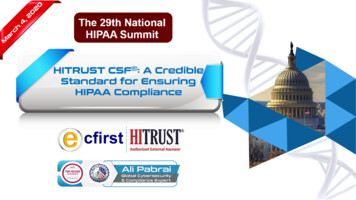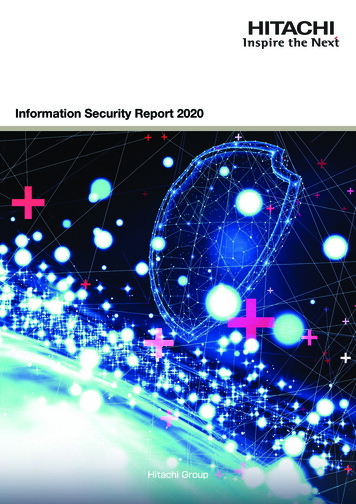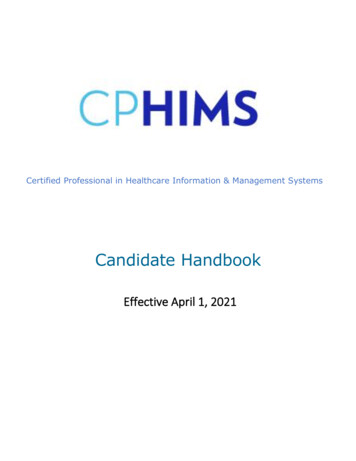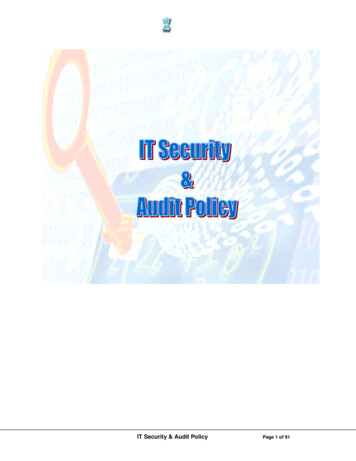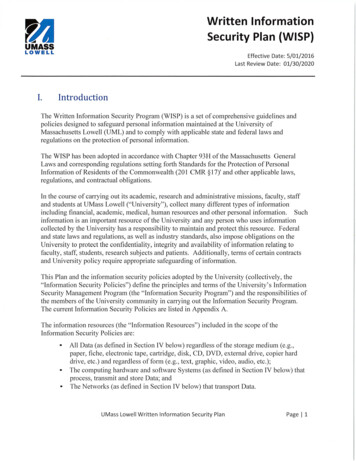
Transcription
Master ThesisComputer ScienceThesis No: MSC-2010:17January 2010Information Security Management of HealthcareSystemA case study of Blekinge Region HealthcareKHALID MAHMOODASHRAFULLAHSchoolSchoolof Computingof ComputingBlekingeBlekingeInstituteInstituteof Technologyof TechnologyBoxBox520520SE –SE372– 37225 Ronneby25 RonnebySwedenSweden
This thesis is submitted to the School of Computing at Blekinge Institute of Technology inpartial fulfillment of the requirements for the degree of Master of Science in Computer Science.The thesis is equivalent to 20 weeks of full time studies.Contact Information:Authors: KHALID .comUniversity advisor:Dr. Sara EriksonSchool of ComputingBlekinge Institute of TechnologySchool of ComputingBlekinge Institute of TechnologyBox 520SE – 372 25 RonnebySwedenInternetPhoneFax: www.bth.se/tek: 46 457 38 50 00: 46 457 102 451
Table of ContentsLIST OF FIGURES . 5LIST OF ACRONYMS . 6ABSTRACT . 7ACKNOWLEDGEMENT . 8INTRODUCTION . 9STRUCTURE OF THE THESIS . 11CHAPTER 1: BACKGROUND . 121.11.21.31.41.51.6ICT FOUNDATION . 12ICT IMPACTS AND HEALTHCARE SYSTEM . 12ICT AND BLEKINGE COUNTY HEALTHCARE PROVIDER . 13HEALTHCARE INFORMATION SECURITY . 14CHARACTERISTIC OF INFORMATION SECURITY . 15FUNDAMENTAL COMPONENTS FOR INTEGRATED SYSTEM . 15CHAPTER 2: PROBLEM DESCRIPTIONS AND GOALS . 172.1 RESEARCH QUESTIONS . 182.2AIMS . 182.3OBJECTIVES . 18CHAPTER 3: RESEARCH METHODOLOGY . 203.1OVERVIEW . 203.2QUALITATIVE RESEARCH METHODOLOGY . 203.3LITERATURE REVIEW . 213.4INTERVIEW. 213.4.1 Top Down Conducting Interview . 223.5FRAME WORK OF METHODOLOGY. 23CHAPTER 4: THEORETICAL WORK . 244.1INFORMATION COMMUNICATION TECHNOLOGY (ICT) . 244.2CHARACTERISTIC AND ROLE OF ICT . 244.2.1 Management System Development . 254.2.2 ICT Integration Support system in Swedish HealthCare . 264.3INFORMATION SECURITY OVERVIEW . 284.4INFORMATION SECURITY MODEL (SIS CLASSIFICATION) . 284.5INFORMATION SECURITY OBJECTIVES . 304.5.1 Confidentiality . 304.5.2 Integrity . 304.5.3 Availability. 304.5.4 Authentication . 314.6INFORMATION SECURITY EVALUATION MECHANISM . 314.7ACCESS CONTROL (AVAILABILITY AND ACCESSIBILITY) . 314.8ACCESS CONTROL CONCEPTS . 324.8.1 Object. 324.8.2 Subject . 324.8.3 Operation . 324.8.4 Privileges or Permission . 324.8.5 Access Control List (ACL) . 324.8.6 Access Control Matrix (ACM) . 324.9ACCESS CONTROL POLICY AND MODEL . 334.9.1 Discretionary Access Control (DAC) . 334.9.2 Mandatory Access Control (MAC) . 334.9.3 Role Based Access Control (RBAC). 344.9.4 Dynamic, Context-Aware Access Control . 344.10ACROSS BORDER (CLIENT-SERVER) COMMUNICATION . 374.11SECURITY ANALYSIS APPROACH . 372
4.11.1Information Security Management System (ISMS) . 384.11.2Plan DO Check Act Approach (PDCA) . 384.11.3ISO Standards of Information Security Management System . 394.12HIPPA SECURITY STANDARDS . 394.12.1Administrative Procedure . 404.12.2Physical Safeguards . 404.12.3Technical data security services . 404.12.4Technical security mechanisms . 404.13EVALUATION TECHNIQUE . 404.13.1Risk Management Evaluation Technique . 414.13.2Standard Risk Analysis . 424.13.3Risk Assessment Evaluation Technique . 424.14SWEDISH HEALTHCARE LAWS AND REGULATION . 43CHAPTER 5: EMPIRICAL WORK . 445.1 CONDUCTING CASE STUDY . 445.3DETAILED QUESTIONS . 455.4QUESTIONNAIRE DESIGN . 455.5PURPOSE OF INTERVIEW. 455.6INTERVIEW INSTRUMENT . 455.7 INTERVIEW REALIZATION . 465.6.1 Interview 1 . 465.6.2 Interview 2 . 475.6.3 Interview 3 . 47CHAPTER 6: RESULTS . 496.16.26.36.46.56.6ACCESS CONTROL PROCEDURE (AVAILABILITY AND ACCESSIBILITY). 49ELECTRONIC HEALTH RECORDS (EHR) OF BLEKINGE HEALTHCARE . 50LAW, STANDARDS, GUIDELINES OF HEALTH CARE . 51ACROSS BORDER COMMUNICATION OF SENSITIVE INFORMATION. 51AWARENESS OF INFORMATION SECURITY IN BLEKINGE COUNTY . 52PRIVACY & SAFETY OF PATIENT IN HEALTHCARE IN BLEKINGE COUNTY . 53CHAPTER 7: ANALYSIS AND DISCUSSION . 547.1ACCESS CONTROL PROCEDURE (AVAILABILITY AND ACCESSIBILITY) . 547.2ELECTRONIC HEALTH RECORDS OF BLEKINGE HEALTHCARE. 557.3LAWS, STANDARDS AND POLICY IN BLEKINGE HEALTHCARE . 557.4ACROSS BORDER COMMUNICATION OF SENSITIVE INFORMATION . 567.5AWARENESS OF KNOWLEDGE OF INFORMATION SECURITY IN BLEKINGE COUNTY . 567.6PRIVACY & SAFETY OF PATIENT IN BLEKINGE HEALTHCARE . 567.7DISCUSSION . 577.7.1 Risk Management. 577.7.2 Policy and Procedures, Laws and Standards in Blekinge Healthcare . 597.7.3 Unawareness. 597.8VALIDITY THREATS . 607.8.1 External Validity . 607.8.2 Construct Validity . 607.8.3 Internal validity . 617.8.4 Conclusion validity . 61CHAPTER 8: EPILOGUE . 638.1 RECOMMENDATIONS . 638.1.1 Risk Management and Risk Assessment . 648.1.2 Information Security Management System (ISMS) . 648.1.3 Awareness and Advocacy . 648.1.4 International Constitutional Legislative Acts . 648.1.5 Access Control . 658.1.6 Dynamic–Context Role Base Access Control (DRBAC) . 658.1.7 Logging Management with Error control . 658.1.8 Standard Software and Hardware . 653
8.1.9 Virtual private Network with SSL Framework . 668.1.10 Multiple Wide Area Network . 668.2 CONCLUSIONS . 668.3 FUTURE WORK. 67REFERENCES . 68APPENDIX . 744
LIST OF FIGURESFigure 1: Health care management SystemFigure 2: Organization of Swedish Health ServicesFigure 3: Health Care Network SecurityFigure 4: Research Question Designation with Aims, Objectives and OutcomesFigure 5: Information Society Evolution StagesFigure 6: Evolution Management SystemFigure 7: Six Action of Swedish Healthcare PlanFigure 8: Information Security Model of SIS 2003Figure 9: DRBACFigure 10: Client and Server Communication PathFigure 11: Information security management system (ISMS)Figure 12: The six Acts that cause an impact on healthcare5
LIST OF VPNAccess Control ListAccess Control MatrixAmerican Recovery and Reinvestment ActClinical Decision Support SystemConfidentiality, Integrity and AvailabilityDiscretionary Access ControlDepartment of Health and Human ServicesDynamic Role Based Access controlElectronic Health RecordsElectronic Protected Health InformationElectronic Patient’s RecordsHealth Insurance Portability and Accountability ActInformation Communication TechnologyIntelligent Decision Support SystemInter-process CommunicationInformation Security Management SystemInformation TechnologyMandatory Access ControlNational Health ServiceNational Program of Information TechnologyNational Security Telecommunication and Information System SecurityOperating SystemPlan DO Check Act approachProtected Health InformationRole Base Access ControlSecure Socket layerVirtual Private Network6
ABSTRACTInformation security has significant role in Healthcare organizations. The Electronic HealthRecord (EHR) with patient’s information is considered as very sensitive in Healthcareorganization. Sensitive information of patients in healthcare has to be managed such that it issafe and secure from unauthorized access. The high-level quality care to patients is possibleif healthcare management system is able to provide right information in right time to rightplace. Availability and accessibility are significant aspects of information security, whereapplicable information needs to be available and accessible for user within the healthcareorganization as well as across organizational borders. At the same time, it is essentials toprotect the patient security from unauthorized access and maintain the appropriate level inhealth care regarding information security.The aim of this thesis is to explore current management of information security in terms ofElectronic Health Records (EHR) and how these are protected from possible security threatsand risks in healthcare, when the sensitive information has to be communicated amongdifferent actors in healthcare as well as across borders. The Blekinge health care system wasinvestigated through case study with conduction of several interviews to discover possibleissues, concerning security threats to management of healthcare. The theoretical work wasthe framework and support for possible solutions of identified security risks and threats inBlekinge healthcare. At the end after mapping, the whole process possible guidelines andsuggestions were recommended for healthcare in order to prevent the sensitive informationfrom unauthorized access and maintain information security.The management of technical and administrative bodies was explored for security problems.It has main role to healthcare and in general, whole business is the responsibility of thismanagement to manage the sensitive information of patients.Consequently, Blekinge healthcare was investigated for possible issues and some possibleguidelines and suggestions in order to improve the current information security withprevention of necessary risks to healthcare sensitive information.Keywords: Information Security, Electronic Health Records, InformationCommunication Technology, patient privacy and security7
ACKNOWLEDGEMENTIn the name of ALLAH, the most gracious, merciful and creator of the universe. We aregrateful to ALLAH who blessed us with abilities and strength to do this thesis work on time.We are thankful and admire the untiring support of our supervisor Dr. Sara Erikson. It wasthrough the guidance and support of our supervisor that helped us in making this thesis worka reality.We express our gratitude for all our Family Members, for providing their untiring supportand prayers during this thesis work. We are thankful to our colleagues Mr. MuhammadUllah, Mr.Farrukh Sahar, Mr.Falakzeb Khan, for extending and sharing cooperation,knowledge and experience with us. Who encourages us to do this thesis work? They allsupported us whenever we were facing problems and struggling to achieve our goals.We are also especially thankful to all healthcare personnel, who gave us constructive, usefulsuggestions and valuable feedback.From KHALID MAHMOOD, a special word of appreciation for my Siblings for being thereason of my achievements here at Blekinge Institute of Technology. This thesis is dedicatedto my Parent, whose prayers are always with me in every sphere of my life.At the end, we are especially thankful to SWEDEN and Swedish people for providing us theopportunity with high quality of education.8
INTRODUCTIONThe information of patients in the form of Electronic Health Records (EHR) or patientelectronic journals is the most important information of healthcare organizations. Thecitizens of county endeavor to get high quality care from healthcare providers. It is thusnecessary for healthcare management to have some well-organized structure or form tomanage the patient’s information and Electronic Health Records (EHR) data in system. Theexisting information and data of patients in healthcare can be classified as sensitive tomanage. Well-organized structure of sensitive information in healthcare management systemaims to provide good opportunities of care based upon the right information to right place inright time [51, 58].RightInformationTo RightPlaceInformationsecuritymanagementIn RightTimeTo rightPersonFigure1: Information security management provide right information to right place in righttime to right personFigure 1 depicts as example that information security management system should have allpossible information with resources, which are required to obtain a high quality health careof patients and good quality health care. It is possible if ensure to have high-levelinformation security for system to have right information to right person in right time to rightplace. The healthcare organization does not have sufficient information about patient’streatment or this is unavailable to management, this way lead to inappropriate treatment ofpatients. The sensitive information of patients in healthcare is managed in a computerizedbased environment, therefore for better protection high-level requirements and needsconcerning security are required. Moreover, an electronic based healthcare system increasesthe availability, accessibility and ease of use of information and resources. The electronicbased management system endeavors to manage the information according to stakeholder’srequirements in several ways. The users should be able to access their information orElectronic Health Records (EHR) across borders organizational through electronic basedinformation system. Implementation of Electronic Health Records (EHR) in health care hasincreased the high quality treatment of patients. The development of electronic based system9
and implementation has been beneficiated healthcare for management but on the other hand,it is a potential security threat and risk to management. Therefore, the potential securitythreats to sensitive information in healthcare violating the patient privacy and patientsecurity [51, 58].Blekinge County is situated in the south east of Sweden. The configuration of healthcarepublic sector in Sweden is organized on national level, regional level. Blekinge Health Careis run by county council and has the sensitive information of patients and providing highquality of treatments to citizens. Electronic based infrastructure has been using since longtime for quality treatment to county citizens. The county citizen records are storedelectronically in healthcare and provided to actors electronically inside but the traditionalway of transmission is papers based across border healthcares. The traditional transmissionway, which is paper bases, is insecure method for communication across border for treatmentpurpose because it does not always guarantee the right information to person in right time.Regarding patient privacy and patient security, both technical and administrative bodies areimportant factors of information security model to prevent from unauthorized access in orderto secure sensitive information [58].Authors have chosen this research after studying of number of information security relatedarticles and research papers concerning different areas. Healthcare is one of the importantareas because it has sensitive information and these resources should be available andaccessible to users in order to support of high quality treatment but other hand it is necessaryto ensure high-level security for the information.We have read literature to obtain a better understandable of effective management ofinformation of security in different areas. To explore properly how it is working, to whatextent the health care system is satisfied within existing information security application andresources today. In addition, does the existing development fulfill the security requirements,standards and needs of health care organizations? Our research methodology was to conductseveral interviews to know the existing information security approach in healthcare andwhether it fulfills the security requirements of management. General case study wasconducted to discover more how the system actually works. After analyzing the currentinformation security structure of Blekinge health care, we have proposed somerecommendations, guidelines. Hopefully, the proposed suggestions will be able to enhancethe information security to sensitive information of health care. High level of patient securitywould be possible to obtain in electronic based healthcare system while still effectingavailability and accessibility. The management properly will use the resources throughsecured way in order to maintain Confidentiality, Integrity and Availability (CIA) [51].10
STRUCTURE OF THE THESISThe structure of the thesis is as follow.Chapter 1 (Background): It is about the background of the topic. Where the authors exploreconcept of ICT implication with information security in healthcare provider organizations.Chapter 2 (Problem Definition/Goals): This chapter discusses relevant problems regardinginformation security in healthcare provider organization. The authors have presented theresearch questions about specified domain with expected aims and objectives.Chapter 3 (Research Methodology): It is about research methodology. This chapter explainsthe literature review, the approach of interview. That is conducted according to specifieddomain of interest.Chapter 4 (Theoretical Work): This chapter is the main part of domain of interest. Thischapter discusses the structure of ICT in healthcare. The information security model isexplained. Different techniques of information security for healthcare provider organizationare discussed. The number of information security characteristic was discussed to ensure theinformation security for organization. Access control with international standards andlegislations acts were explained for security purpose.Chapter 5 (Empirical Work): This chapter discusses empirical study of this research. Thedetails questions were designed before for conducting interview from healthcare personnel.The designed questions were asked about our domain of interest from Blekinge healthcareprovider. Different personnel were selected for conducting the interview. The simple casestudy was also conducted just to overview the current system of this county.Chapter 6 (Results): This chapter describes the possible result, where the authors haveachieved from interviewees personnel of Blekinge healthcare provider. The focus was theaccess control, electronic health record, laws, standards and guidelines. This part alsodiscusses the communication of information across borders.Chapter 7 (Analysis and Discussion): The result from chapter six were discussed andanalyzed in this chapter. The conclusion regarding information security was explained in thischapter also.Chapter 8 (Epilogue): This chapter is included of the recommendations of research study.The conclusion and future work of this study (management of information security) arediscussed.11
CHAPTER 1: BACKGROUNDIn this chapter, the authors have focused the Information Communication Technology (ICT)scope and impacts in healthcare provider’s organizations. In addition, the informationsecurity regarding ICT discussed. We know that number of organizations depends on theICT based structure. The main purpose of ICT is to make cost effective and well-organizedenvironment in organizations [1].The important role of ICT is the facilitation of accessibility to resources in organizations.Furthermore supporting and enhancing the knowledge of the users and supportingcommunication between users. The implementation of ICT has provided a framework foraccess and utilization of resources [2].1.1ICT FoundationThese are the following foundation of ICT.a) Informatics: Informatics has to explore the area of computer science withevaluation, realization, processing system for information, S/W, H/W and aspect ofhuman beings [2].b) Informatics Technology: IT has to deal with the applications related technologicalaspect of informatics [2].c) Information and communication technology: it deals with the combination ofinformatics technology and communication technology and as a result defines theapproach of ICT [2]. Information Technology and Communication Technology withapplications have cost-effective approach, faster information transportation [6].Knowledge management has to identify in term of ICT the enhancement of knowledgesharing and the improvement to access the required information concern and about toknowledge. Sharing the knowledge relatively is concerned to communication. Further, thesuggestion of management is the information distribution of knowledge among differentfactors in organization. Therefore, for management system having ICT infrastructure, theoperation of internal and external knowledge sharing has to impose what kind of knowledgeand its strategy in order to recognize properly the flow information in organization. For thispurpose, ICT has developed a structure to keep the flow of information well organized, lesstime consuming and to make available the resources [3].1.2ICT Impacts and Healthcare systemInformation is important for organization. There is vital role of Informatio
if healthcare management system is able to provide right information in right time to right place. Availability and accessibility are significant aspects of information security, where applicable information needs to be available and accessible for user within the healthca
